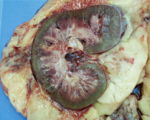Difference between revisions of "Renal Disease (Chronic) - Donkey"
Jump to navigation
Jump to search
| (3 intermediate revisions by one other user not shown) | |||
| Line 1: | Line 1: | ||
| + | {{review}} | ||
[[Image:Pyelonephritis donkey.jpg|right|thumb|150px|<small><center>Pyelonephritis (Image courtesy of [http://drupal.thedonkeysanctuary.org.uk The Donkey Sanctuary])</center></small>]] | [[Image:Pyelonephritis donkey.jpg|right|thumb|150px|<small><center>Pyelonephritis (Image courtesy of [http://drupal.thedonkeysanctuary.org.uk The Donkey Sanctuary])</center></small>]] | ||
| − | This is much less common than hepatic disease. It is often seen in multiorgan failure in the terminally ill donkey. There is also some association with urinary calculi, [[Hyperlipaemia - Donkey|hyperlipaemia]] and [[Colic - Donkey|colic]]. Again, animals with end-stage disease from a chronic condition will usually present as '''[[Dull Donkey|dull]] and anorexic''' although renal disease can be extremely painful and, in T. Sprayson’s experience, affected donkeys can present with signs of acute colic. | + | This is much less common than hepatic disease. It is often seen in multiorgan failure in the terminally ill donkey. There is also some association with urinary calculi, [[Hyperlipaemia - Donkey|hyperlipaemia]] and [[Colic - Donkey|colic]]. Again, animals with end-stage disease from a chronic condition will usually present as '''[[Dull Donkey|dull]] and anorexic''' although renal disease can be extremely painful and, in the T. Sprayson’s experience, affected donkeys can present with signs of acute colic. |
| − | |||
| − | |||
| − | |||
| − | |||
| − | |||
| − | |||
| − | |||
| − | |||
| − | |||
==References== | ==References== | ||
Revision as of 12:08, 7 March 2010
| This article has been peer reviewed but is awaiting expert review. If you would like to help with this, please see more information about expert reviewing. |

This is much less common than hepatic disease. It is often seen in multiorgan failure in the terminally ill donkey. There is also some association with urinary calculi, hyperlipaemia and colic. Again, animals with end-stage disease from a chronic condition will usually present as dull and anorexic although renal disease can be extremely painful and, in the T. Sprayson’s experience, affected donkeys can present with signs of acute colic.
References
- Sprayson, T. (2008) The care of the geriatric donkey In Svendsen, E.D., Duncan, J. and Hadrill, D. (2008) The Professional Handbook of the Donkey, 4th edition, Whittet Books, Chapter 13
|
|
This section was sponsored and content provided by THE DONKEY SANCTUARY |
|---|